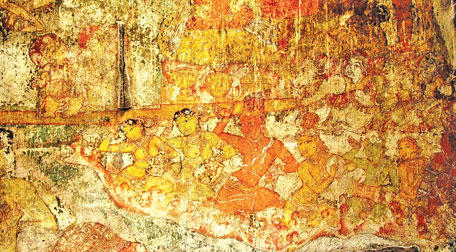The impact of paintings on dance
by Subashini Pathmanathan
Apart from sculpture and inscriptions, paintings which adorned the
walls of the dance halls, royal palaces and the temple courtyards convey
information on dance. Oriental paintings, especially the Indian
paintings, can be seen in several regions. For instance, the style of
North Indian paintings is quite different from that of the South Indian
paintings. The South Indian paintings also could be categorised on the
basis of religion, region, culture and different periods.
|

A Thanjore painting |
Ancient South Indian paintings are generally divided into two
categories. One is sketch drawings without colours.
The other is colour paintings. The sketch drawings existed even in
ancient times. It is evidenced by certain verses appearing in the epic
Manimekali and Nedunelvadi.
Frescoes
The ancient South Indian and Sri Lankan paintings are closely
associated. For instance, the Sigiriya frescoes resemble the Thanchai
Bragatheeswarar temple paintings.
Most of these paintings reflect the social, political and cultural
influence of their time.
The Silapatikaram, the ancient Tamil classic, says that in the dance
halls where, Mathavi held the Arangetrams there were four paintings,
depicting brahmins, kings, merchants, and vellalas.
Ancient paintings also depict the dances on the pillars of the dance
halls, on the Hindu temple walls, on the royal palace walls and on the
inner walls of the caves.
And beautiful dance paintings were also seen on the curtains.
Most of the ancient research, dealing with dances, in the Tamil
paintings begins with the Pallava period. Although the Pallava period
reflected the continuations of earlier periods, there is no concrete
evidence to support it. Mainly the paintings which have been studied
date from the 7th century A.D. Among the Pallava kings, Mahendravarman,
who was celebrated as a famous painter was called 'tiger among the
painters'.
Mahendravarman's skill in painting was recognised according to a
stone inscription. He wrote a thesis on the paintings Thatchana
Chithiram. During the Pallava period the paintings received a boost.
Paintings related to dance were also painted on the walls and in the
cave walls.
Certain verses in ancient works show that to enable the dancers to
learn the dance, strictly according to the tradition, they were
encouraged to learn from works on paintings.
In the famous Chithanal caves, during Mahendra Varman's reign by his
order, numerous paintings were painted.
One of the most celebrated paintings that of Lord Nataraja, the
cosmic dancer, at the entrance of the cave was painted during his
period.
In the 7th century after seeing this excellent painting that the
saint Thirunavukarasa Nayanar sang "what else is there to see!".
Pallava period
The cave paintings, during the Pallava period, still appear in the
Kanchi Kailasa Nathar temple and Mamandur Caves. Following the Pallava
period, the paintings received a boost. After the Pallava period no
outstanding cave paintings could be seen anywhere else in the Tamil
country.
After the Pallava period in the Tamil history the golden era in the
Tamil country started. During the Chola period Thanjai Bragatheeswarar
temple was built by the great Chola emperor the Raja Raja Chola 1.
At Thanjai Bragatheeswarar numerous wall paintings can still be seen.
One of the paintings depicts Lord Siva seated on a tiger skin and
watching a dance performance of the Apsaras (Devaloka dancers).
Another painting depicts the cosmic dance of Lord Nataraja, watched
by the devotees and by the Brahamins on one side, and on the other the
ruler Raja Raja Chola 1 and his three consorts enjoying the performance.
Another dancing figure of a danseuse also could be seen among the
Thanjai Bragatheeswarar temple paintings.
Tragically, once the most famous paintings on the walls of the
Thanjai Bragatheeswarar temple were damaged by a fire.Even more
beautiful ancient wall paintings decorate the walls of Sri Rangam
temple.In most of these paintings, the expressions are very clear.
Unlike sculptures and rock inscriptions, the paintings are likely to
suffer damages and destructions due to natural or manmade causes. |


